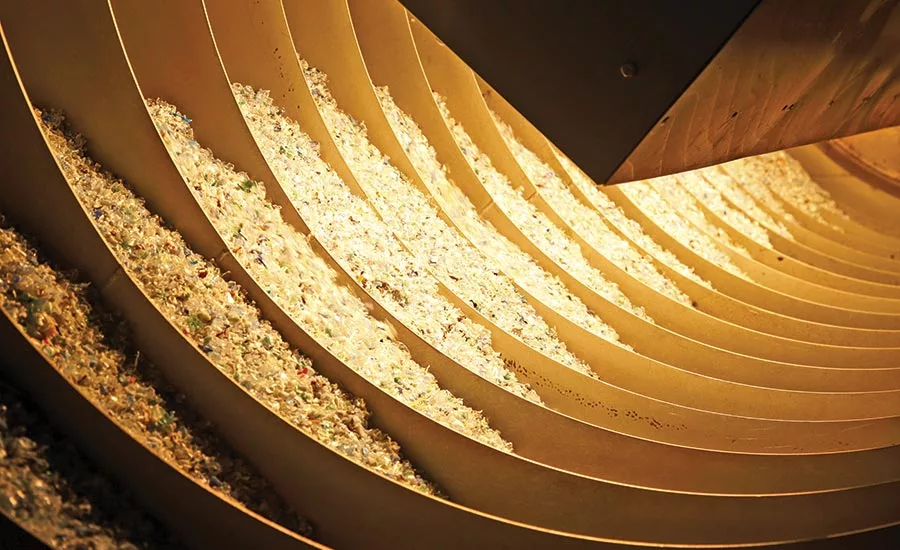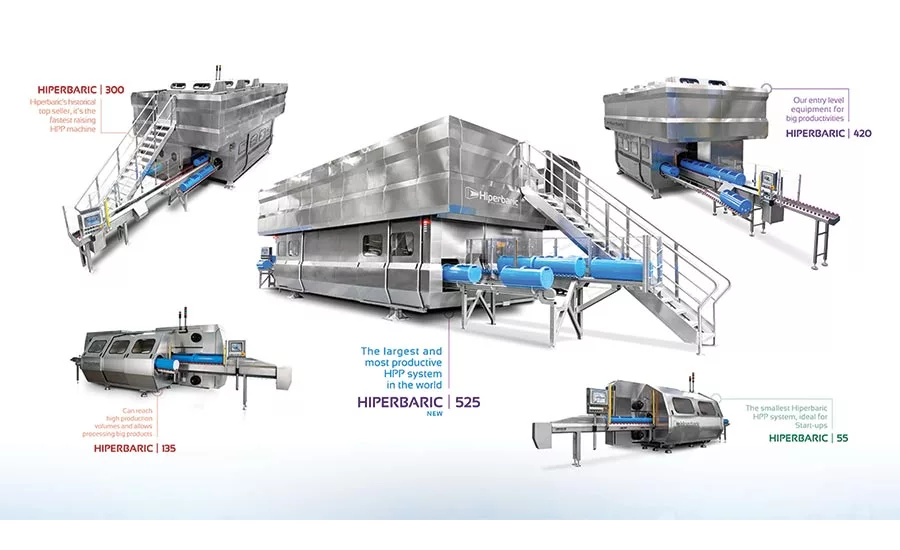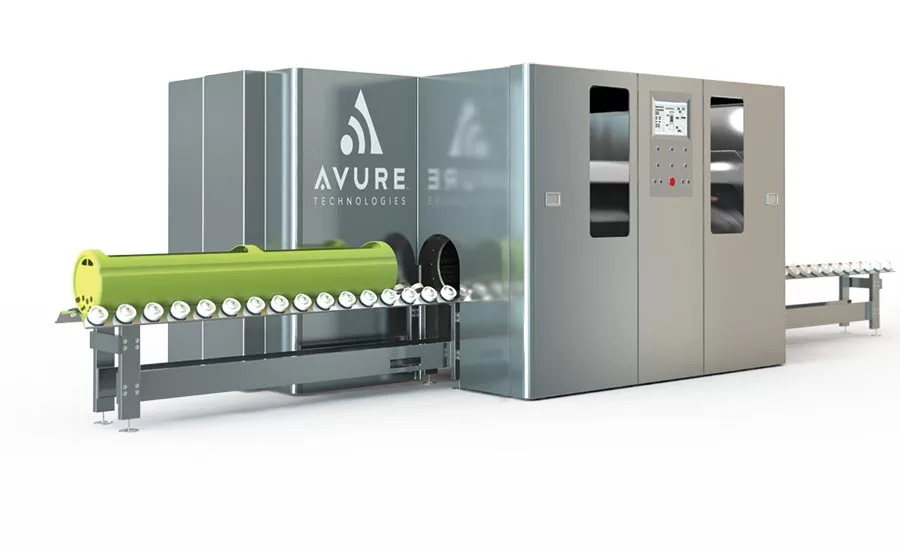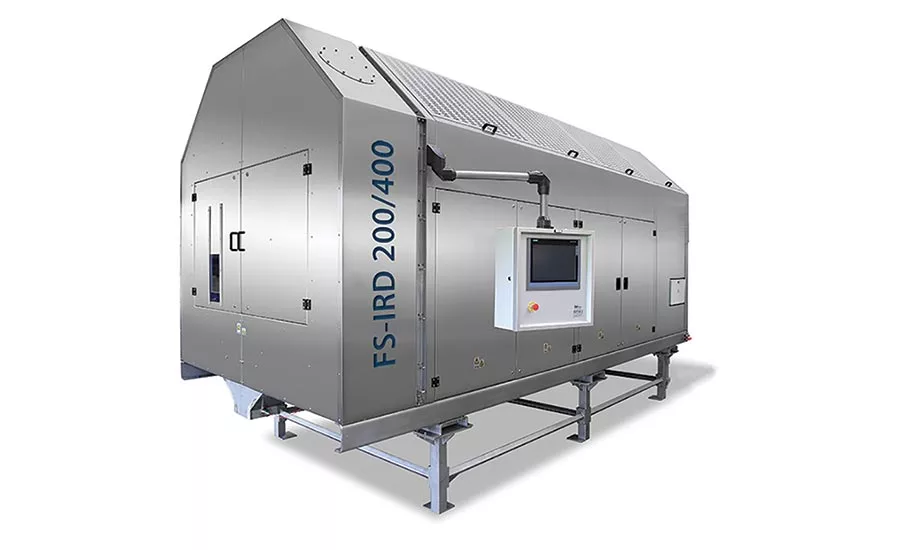Tech Update
Alternative processing helps meet consumer cravings
Innovative brands are adapting new technologies to create the novel food and beverage products consumers are craving.

Kreyenborg’s FoodSafety-IRD is used to treat bulk foods, such as tea, spices, dried herbs, nuts and seeds. Source: Kreyenborg.

Hiperbaric’s product line of HPP equipment. Source: Hiperbaric.

JBT recently acquired Avure, one of the companies manufacturing HPP equipment. Source: JBT/Avure.

Kreyenborg’s FoodSafety-IRD equipment uses infrared light to reduce germs, such as bacteria, yeasts and mold, as well as pathogens. Source: Kreyenborg.
A seismic shift in consumer attitudes toward food and beverages is happening. No longer are food and drink judged on taste alone; instead, people want to know how nutritious they are, how they are going to make them feel and what ingredients they contain.
A recent CPG sales report released by The Boston Consulting Group and IRI found companies that market convenient foods and “functional” beverages aimed at promoting nutrition or boosting energy were among the CPG growth leaders in 2016. In a year that was otherwise sluggish, companies such as Blue Diamond, Califia Farms, Bragg and The Wonderful Company outperformed expectations.
Other marketing and research firms also are advising those in the food and beverage industry that consumers want a completely different type of product now than they did a decade ago.
“The interesting thing about this move in the marketplace toward cleaner labels, authenticity and transparency is it is consumer driven,” says Jeff Hilton, co-founder and CMO at BrandHive, a marketing firm.
This new type of consumer is highly evolved and has an extensive amount of information and choices at his or her fingertips. But moreover, Hilton says modern consumers are becoming increasingly wired with technology that measures heart rates and sleep patterns, which is empowering them to take charge of their health and contributing to the spike in demand for healthy foods.
“This is the perfect storm of opportunity, where consumers are ready for these kinds of solutions, ready for these kinds of food products, with cleaner labels and better ingredients, ready for this kind of transparency and authenticity,” Hilton says. “It’s really up to manufacturers to deliver what they are looking for.”
Luckily, a host of new processing technologies is coming onboard to help CPG companies deliver fresher and more nutritional packaged foods and beverages than ever before. A mix of alternative food processing methods is changing the game for some brands right now and might vastly change the typical products available in the marketplace in the near future.
Non-thermal processing
Traditionally, heat has been used to preserve processed food and beverages, making them safe to eat. Thermal processing is an effective way to treat foods; in fact, our modern food system has largely been built by it. However, food exposed to high temperatures can alter taste, texture and nutritional value.
“Conventional thermal processing was invented for all the right reasons, so that pathogens would be removed from our food,” says Michael Locatis, CEO of 915 Labs, a company that developed a new type of sterilization process using a combination of water bath with microwave energy. “[Conventional thermal processing] also causes significant damage to the flavor, texture, color and nutritional content of food, which forces food companies to use additives to mask that damage.”
Also, there are some foods that cannot be exposed to traditional thermal processing, such as raw oysters or produce, because it will alter them too much. To accommodate these foods, there are a number of methods being developed that do not use heat, but will still destroy pathogens and retain the product’s freshness. Some of these techniques include high-pressure processing, using different types of gases and radiation.
Food Engineering has been covering many of these novel techniques, such as in the November 2016 Engineering R&D column interview with Rob Wong, the creator of NeoPure. This is a non-thermal sterilization method designed to kill “bugs,” but preserve the flavor and texture of low-moisture foods, such as RTE seeds, grains and sprouts. Neo-Pure is derived from plants and is formulated as a liquid to be applied by misting it directly onto foods. The solution has been proven to be effective in killing bacteria and spore formers.
“Its mode of action is that it uses oxygen as a disruptor of the cell structure of pathogens, denaturing multiple parts of microbial cells [i.e., cell wall, DNA, enzymes] in a multi-site mode of action,” according to Wong, which reduces pathogens without affecting foods’ nutritional properties.
HPP
The non-thermal pasteurization method gaining a lot of popularity recently is high-pressure processing (HPP). HPP machines are designed to inactivate pathogenic bacteria, rendering the food or beverage product safe and extending its shelf life.
Approved by FDA and USDA, HPP is a cold pasteurization technique and, thus, does not alter heat-sensitive foods, such as meats, fruits and vegetables. The process can also be used for both organic and natural foods. But perhaps, the biggest selling point with this method is that the flavor, vitamins and nutrients of the natural food are all preserved.
“With HPP, characteristics of the fresh product are retained; sensorial and nutritional properties remain almost intact,” says Alexander Marquis, marketing manager for Hiperbaric.
Therefore, this technology can help introduce new products into the marketplace, and companies can respond to the consumer demands for cleaner label products.
“Processors can offer a greater number of refrigerated products, which are healthy and more profitable,” says Lisa Pitzer, marketing director of JBT’s Avure Technologies. “In some cases, frozen products can be changed with HPP to the refrigerated space—located in the ‘healthy’ perimeter of grocery stores.”
Pitzer cites one example of a new product being brought to market through HPP: Bolthouse’s popular new line of yogurt-based salad dressings, which were developed in the JBT/Avure HPP Customer Center from scratch.
There have been many other innovative products introduced through HPP capabilities, says Mark Fleck, HPP consultant for Universal Pasteurization, such as certain refrigerated nut milks and coffees, fresh baby foods and convenient ready meals.
HPP technology works by using pure, potable water and pressure to destroy pathogens.
“Food items, already placed into their final packaging, are put into vessels that subject them to as much as 87,000 psi [of pressure],” says Fleck. “This isostatic pressure disrupts the cellular function of harmful microorganisms that may exist.”
This means the pathogens are rendered inactive without the use of chemicals, heat or additives. Also, because HPP does not break covalent bonds, the small chemical constituents like flavor compounds, vitamins and nutrients are not affected or cooked away.
“HPP also reduces drastically the overall microbiological spoiling flora. Therefore, there is a higher quality shelf life,” says Marquis.
Additionally, this process allows a product to be shipped and stored refrigerated rather than frozen, as Pitzer mentioned previously. This is an attractive feature for processors because it provides economic and time-saving benefits. It also appeals to retailers due to the refrigerated product having an extended shelf life, typically increasing it by two times.
The steps of the HPP process are rather straightforward, beginning with product being put into hermetically sealed packages, such as bags, pouches, plastic bottles, etc., and loaded into HPP carrier baskets. The baskets are then inserted into the HPP vessel. The vessel enters the system and is sealed by plugs. Next, potable water is pumped into the vessel, creating equal pressure on all sides of the packages.
Product is then held at a pressure of 45,000 to 87,000 psi for one to six minutes, depending on the HPP process recipe. This pressure, transmitted uniformly throughout the product, disrupts the microbial biochemistry of bacteria and spoilage microorganisms.
One important area to note is the packaging. The type of packaging used in HPP processing must be carefully considered for a number of reasons. Since there is a temporary volume change of up to 15 percent, at least one package surface must be flexible to accommodate the pressure buildup, which is released once the product exits the equipment and will cause the package to spring back.
Additionally, air impacts the efficiency of the HPP process, causing a longer cycle time because it takes the additional time to compress more air. Thus, it is important for package headspace to be minimized to optimize basket fill efficiency and cycle time.
There are a number of food and beverage applications that are ideal for HPP, and many new entrepreneurs are enjoying success from using the technology. When HPP was first introduced in the early 2000s, ready-to-eat meat processors were among the first to adopt it. However, in recent years, there has been a huge growth of juices and drink products using HPP.
“In the juices, HPP is a great option for keeping fresh flavor,” says Marquis. “This non-thermal process keeps original fruit/vegetable taste and color, allowing for the creation of the highest-quality premium range of products and the real taste of a freshly squeezed juice.”
However, not all foods are ideal candidates for HPP, especially dry products, such as spices, powders, cereals and nuts.
“Isostatic pressure needs water inside of the food product for an efficient transmission,” says Marquis. It is this pressure that causes the inactivation of microorganisms. “[Some] raw, fresh pieces of produce do not constitute such a high-value product, and more importantly, the isostatic pressure causes certain changes in the texture and in the cell walls.”
For other products, like halved avocados and fresh guacamole, HPP has been extremely beneficial since the process not only preserves their freshness, it also extends the shelf life. For example, the usual shelf life of a cut, untreated avocado is very short, sometimes just a few hours, but an HPP-processed avocado has the shelf life of 25-30 days.
Producers of fresh food products wanting to expand their business have also turned to HPP. Universal Pasteurization’s Fleck gives the example of Jack Aronson, the founder of the salsa business Garden Fresh Gourmet, who had received an order from Costco, but realized his product didn’t have the shelf life to go through national distribution. He then used HPP to extend his salsas’ shelf life and grew his business’s revenue from $4.6 million in 2002 to over $100 million ten years later. He has since sold the business to Campbell for $231 million.
For processors looking to add HPP capabilities to their operations, Pitzer says equipment that best suits their needs can be installed directly into a plant and expanded later.
“As the company grows and volume expands, the machine can be upgraded to keep up with increased demand,” she says.
However, for smaller companies or even startups that do not have the floor space or the capital necessary for the machinery, there are other options.
“They’re able to use an HPP toll processor, who will prepare products for a cost per piece, pound, bottle, etc.,” says Pitzer. “With Avure HPP, producers are manufacturing in record volumes, reducing shrinkage and growing their distribution overnight.”
Alternative processing: Infrared light and microwave energy
As previously mentioned, HPP does not work on all food products, including dry products. Because processors have had some problems in the recent past with the possible pathogen contamination of nuts, spices and seeds (for instance, the SunOpta sunflower recall of 2016 that triggered numerous other recalls of product that contained the seeds), these are products that are particularly in need of a food safety treatment.
Kreyenborg has developed a technology for germ reduction called Food Safety-IRD, which uses infrared light to stimulate food particles from the inside to the exterior. Traditionally,germ reduction has been achieved through burning the product from the outside with conventional dryers.
“Energy is instantaneously beamed into the core of the product,” says Wilfried Binternagel, area sales manager for Kreyenborg. “An energized hot airflow, such as convective thermal process, is not required.”
Kreyenborg performed over 5,000 disinfection analyses and found the Food Safety-IRD technology showed not only a germ reduction significantly above 10 log 5, but also sensory damage that could scarcely be detected compared to traditional procedures.
“The FoodSafety-IRD is protecting the shape, texture, taste and the ingredients in a better way than thermal processes,” says Binternagel. “The energy consumption of this process is much lower, and the process is much faster.”
Another technology called MATS, or microwave-assisted thermal sterilization, is considered an alternative processing technology because it treats packaged foods via pressurized hot water and simultaneously heats it with microwaves at a frequency of 915 megahertz. This technology minimizes the food exposure to high heat—typically five to eight minutes—preserving nutrients, texture and flavors better than the traditional method, which requires vacuum-packaged food to be placed in a pressurized cooker at temperatures above 250°F for up to an hour.
“Additives and excess salt to compensate for heat damage to food during the sterilization process are eliminated with MATS,” says Mary Henderson, marketing director for 915 Labs. “MATS allows food manufacturers to produce more nutritious, clean-label foods, allowing foods to retain more micronutrients than conventionally sterilized foods.”
Analysis tests performed show approximately 69 percent of thiamine was retained in MATS-processed salmon filet versus 31 percent of the vitamin in retort. For these reasons, Henderson adds, this technology opens up new possibilities for packaged foods that have not been successfully processed in the past, especially heat-sensitive and protein-rich foods, such as eggs, dairy, seafood and pastas.
It is clear that all this technology is moving towards preserving foods in a more efficient and healthful way. And if the past decade is any indication of future consumer trends, the demand for more nutritional and better-for-you foods will only grow, making these methods more attractive for CPG brands and processors looking to expand their product offerings.
HPP verification ink helps ensure food safety, prevents counterfeiting

A high-pressure indicator “ink” is now available for processors wanting to indicate on a package that the food has undergone HPP. Developed by Chromatic Technologies Inc. (CTI), a manufacturer of thermochromic materials for packaging, the HPP verification technology is a first for the inks and food industries worldwide.
One of HPP’s advantages is that the product subjected to it looks identical to products that have not undergone HPP treatment. However, this can be a huge weakness, as it is impossible to know by visual inspection whether or not a product has been HPP treated. This can create a challenge for all in the supply chain, as well as open up the possibility of food fraud, which is why CTI has developed this technology.
The immediate demand that CTI is fulfilling is from foodservice companies that are receiving shipments of HPP foods, such as meat, seafood, cheese, juice and vegetables, and need to give their restaurants or grocery stores a quick visual indicator of whether they should accept delivery of food products.
“If you’re the vice president of food safety,” explains Patrick Edson, chief marketing officer of CTI, “you are managing a significant risk profile of millions of units of food packaging being delivered to your business under the assumption it has been processed through HPP.
“Customers tell us, ‘We only need one package to bypass the HPP machine, and we have a huge problem,’” says Edson. But a visual cue to indicate it has been subjected to high pressure can mitigate that risk. “It also provides regulatory agencies with the ability to confirm that the foods have undergone HPP.”
CTI’s patent-pending HPP-indicator technology is delivered via an ink that can be printed on the exterior of most packages for the marketplace. The ink is clear when printed and then increases in color as it’s exposed to the very high isostatic pressures found in the HPP process. The first generation of technology can differentiate between pressure exposure <20,000 psi, 20,000 psi, 30,000 psi and >40,000 psi, according to Edson.
The CTI technology is applied like all conventional inks used in packaging and is currently available in water-based and ultraviolet (UV)-cured inks. Solvent-based inks will be available in the future, if the demand justifies the development expense.
CTI’s new ink technology for HPP also contains anti-counterfeiting features to ensure a company hasn’t simply printed an ink on its packaging claiming an HPP indicator. CTI’s new process provides an easy visual confirmation of successful HPP.
CTI’s offering of HPP verification technology is now available for sale.
For more information on Chromatic Technologies Inc., visit www.ctiinks.com.
For more information:
Wilfried Binternagel, +49 2597 939970,
info@kreyenborg.com, www.kreyenborg.com
Mark Fleck, Universal Pasteurization, 678-840-1500,
mfleck@ucsne.com, www.universalpasteurization.com
Mary Henderson, 915 Labs, 812-361-3727,
www.915labs.com
Alexander Marquis, Hiperbaric, 305-639-9770,
info@hiperbaric.com, www.hiperbaric.com
Lisa Pitzer, JBT/Avure, 513-433-2500,
info@avure-hpp-foods.com, www.avure-hpp-foods.com
Looking for a reprint of this article?
From high-res PDFs to custom plaques, order your copy today!







